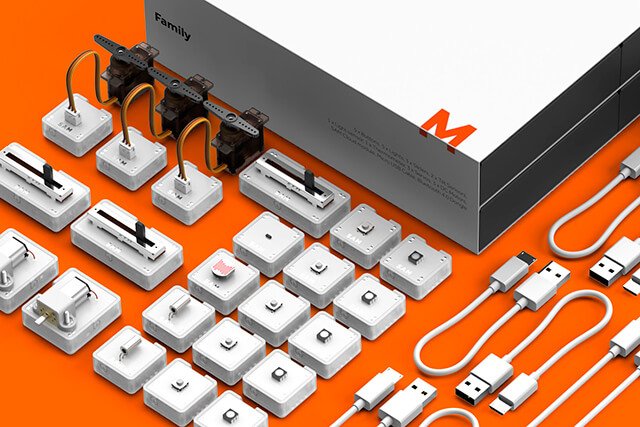UK creative consultancy Map and technology company SAM introduced a new kit that will facilitate development of internet-connected products.
London-based creative consultancy Map, founded by Barber and Jay Osgerby, together with technology firm SAM have developed a toolkit, which is expected to make it easier to create Internet-connected products. The kit includes Bluetooth-enabled modules that connect through an application or a cloud storage system.
“There was no really easy way to create a product, an app, or a piece of art using electronics and coding,” Joachim Horn, SAM CEO, told Dezeen.
“I thought this was crazy as it basically meant cutting off the majority of the designers who haven’t had the luxury to have a technical education,” he said.
In addition to the digital software, the companies have been working together on the development of the physical modules, which include actors and sensors. While the actors are responsible for outputs, including buzzers, motors and lights, the sensors ensure input, such as pressure sensors, buttons and thermometers.
The sensors send information through Bluetooth to the software that reads and interprets it. Instructions are then transferred to the actors, which then implement the tasks.
The modules can be located everywhere, because each block is equipped with a lithium polymer battery and a bluetooth low-energy antenna, what eliminates the need for wires. All the electronic components are hidden inside each block, which are covered with an elastomer band.
“There are no wires to get tangled in or complexities around fault finding, and it really does free up inputs and outputs to be physically separated from one another and create genuine IoT experiences,” designer at Map, Paul Wolfson, told Dezeen.
The new toolkit is aimed at educating students and designers about the computer science and electronics.
“[The Internet of Things] is becoming essential. The boundaries have blurred between the world of physical and digital products, and the potential to connect one thing to another is huge. This doesn’t just mean physical objects talking to one another but talking to broader services and experiences, which might only exist digitally,” Wolfson stated.
A growing number of companies are now working on the development of electronic products and make programing more accessible and relevant to people. Design and education company, Technology will save us, has recently presented a new programmable pocket-sized device that aims to help children in the UK to develop their creativity.
A few weeks ago, Cisco introduced a new IoT System framework that enables operators to monitor and customize IoT network infrastructures for industrial scale. Furthermore, the firm expanded its portfolio with IoT networking products, including an industrial switch, two IP cameras and a total of seven new routers, created for rough environments in manufacturing, transportation and other IoT fields.
Last months, an American multinational corporation Freescale Semiconductor Inc. developed the globe’s smallest single chip module for the IoT that will function as a computer on a chip.
In general, the IoT industry is demonstrating steady growth now. According to Intel CEO Brian Krzanich, the IoT was among the three areas, in which the company recorded a significant increase. The company’ net income for Q2 2015 amounted to $2.7 billion.
By the way, the IoT growth is observed not only in software, science or household segments, but in entertainment as well. The hit game from the 1990s, Tamagochi, began supporting interlinking between devices. Now you can simply exchange data by bumping the toys together.
